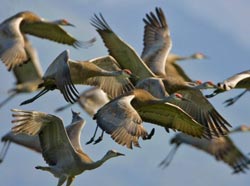Anchorage Coastal Wildlife Refuge
Wildlife Viewing

The Anchorage Coastal Wildlife Refuge extends sixteen miles along Anchorage's coastline from Point Woronzof to Potter Creek, providing excellent opportunities to view migrating snow geese and sandhill cranes.
From mid-April to early May, the refuge is a critical resting and feeding place for snow geese migrating from British Columbia and Washington to Wrangel Island, off the coast of Siberia. The snow geese feed constantly while in the refuge because they must arrive on Wrangel Island with enough protein and fat to lay eggs immediately. If egg laying is delayed, goslings may not be developed enough to fly before freeze-up.
The refuge is also a great spot to see sandhill cranes. Watch these long-legged birds foraging in the salt marsh. They dine on marine worms, sticklebacks, frogs, rodents, insects, rhizomes, seeds, and berries. Their primitive, rattling calls can be heard for over a mile. The mating dance of the sandhill is a wondrous sight. They begin their dance with deep bows followed by intricate leaps, hops, skips and more bows. Cranes are thought to be the oldest family of birds still living on Earth.
Viewing and Safety Tips
Large numbers of sandhill cranes also fill the sky near Creamer's Field in Fairbanks during spring migration. The 5-6 hour drive north from Anchorage to Fairbanks passes Denali National Park and Preserve and miles of scenery along the Parks Highway.
Snow geese can also be seen in spring on the Kenai Flats, several miles south of downtown Kenai. The town of Kenai is several miles north of Soldotna. The drive along this Scenic Byway takes about 3 to 31/2 hours from Anchorage.
Directions
Lying below the coastal bluff, the refuge is accessed via the Tony Knowles CoastaI TraiI, Kincaid Park motocross area, Johns Park, or the south ends of Victor Road or Reef Drive in South Anchorage.
Resources
Visit the Anchorage Coastal Wildlife Refuge page for more information.
